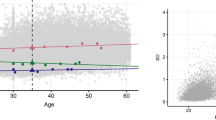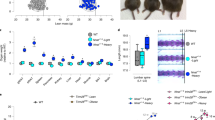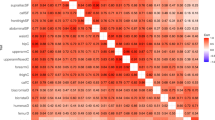Abstract
OBJECTIVE: To assess intrapair resemblance in changes of body weight, total body fat, fat distribution, resting metabolic rate, fasting respiratory quotient and cardiovascular disease risk factors in response to therapeutic weight loss in female obese identical twins.
DESIGN: Patients stayed for 40 days on an inpatient metabolic unit under careful supervision. The stay was divided into three parts: an initial period of 7 days for adjustment to the hospital environment and for baseline measurements, 28 days of the weight reduction regimen when negative energy balance was achieved mainly by a very low calorie diet (1.6 MJ per day) and 5 days of testing after weight reduction.
SUBJECTS: Fourteen pairs of premenopausal female obese identical twins (age: 39.0±1.7 y; body weight (BW): 93.9±21.2 kg; body mass index (BMI): 34.2±7.8 kg/m2) participated in the study.
MEASUREMENTS:. Before and after weight loss, the following measurements were made: body composition by anthropometry and hydrodensitometry, intra-abdominal fat by ultrasonography, resting metabolic rate by indirect calorimetry. Total cholesterol, high-density lipoprotein-cholesterol, triglycerides and uric acid were determined by standard laboratory procedures. Blood pressure was measured in the morning in the recumbent position.
RESULTS: Subjects lost 8.8±1.9 kg of weight, from 93.9±21.2 to 85.1±10.9 kg (P<0.0001) and 6.5±2.3 kg of body fat (P<0.001). Weight losses varied widely among subjects, with a high correlation between losses of members of twin pairs for body weight (r=0.85; P<0.001) and for body fat (r=0.88; P<0.0001). Changes in uric acid resulting from weight loss were also correlated among members of twin pairs whereas changes in blood pressure, cholesterol and triglycerides were not.
CONCLUSION: The great intrapair resemblance observed in very low calorie diet-induced weight and fat losses in female obese identical twins suggests an important role of genetic factors in response to the weight reduction regimen.
This is a preview of subscription content, access via your institution
Access options
Subscribe to this journal
Receive 12 print issues and online access
$259.00 per year
only $21.58 per issue
Buy this article
- Purchase on Springer Link
- Instant access to full article PDF
Prices may be subject to local taxes which are calculated during checkout


Similar content being viewed by others
References
Zhang YU, Proenca R, Maffei M, Barone M, Leopold L, Friedman JM . Positional cloning of the mouse OB gene and its human homologue Nature 1994 372: 425–432.
Pérusse L, Chagnon YC, Weisnagel J, Bouchard C . The human obesity gene map: the 1998 update Obes Res 1999 7: 111–129.
Montague CT, Farooqui IS, Whitehead JT, Soos MA, Rau H, Wareham NJ, Sewter CP, Digby JE, Mohammed SN, Hurst IA, Cheetham CJ, Earley AR, Barnett AH, Prins JP, O'Rahilly S . Congentital leptin deficiency is associated with severe early-onset obesity in humans Nature 1997 387: 903–908.
Comuzzie AG, Allison DA . The search for human obesity genes Science 1998 280: 1374–1377.
Pérusse L, Tremblay A, Leblanc C, Cloninger CR, Reich T, Rice J, Bouchard C . Familial resemblance in energy intake: contribution of genetic and environmental factors Am J Clin Nutr 1988 47: 629–635.
Tarusk V, Beaton GH . The nature and individuality of within-subjects variation in energy intake Am J Clin Nutr 1991 54: 464–470.
Bouchard C, Pérusse L . Genetics of obesity Ann Rev Nutr 1993 13: 337–354.
Ravussin F, Bogardus C . Relationship of genetics, age, and physical fitness to daily energy expenditure and fuel utilization Am J Clin Nutr 1989 49: 968–975.
Roberts SB, Savage J, Coward WA, Chow B, Lucas A . Energy expenditure and intake in infants born to lean and overweight mothers New Engl J Med 1988 318: 461–466.
Bouchard C, Tremblay A, Després JP, Nadeau A, Lupien PJ, Thériault G, Duussuault J, Moorjani S, Pinault S, Fournier G . The response to long-term overfeeding in identical twins New Engl J Med 1990 322: 1477–1482.
Bouchard C, Tremblay A, Despres JP, Thériault G, Nadeau A, Lupien PJ, Moorjani S, Prudhomme D, Fournier G . The response to exercise with constant energy intake in identical twins Obes Res 1994 2: 44–410.
Bouchard C, Tremblay A, Després J-P, Nadeau A, Lupien PJ, Moorjani S, Thériault G, Kim SY . Overfeeding in identical twins: 5-year postoverfeeding results Metabolism 1996 45: 1042–1050.
Hainer V, Kunesova M, Stich V, Parizkova J, Zak A, Wernischova V, Kozich P, Hrabak P, Dedicova L . Very low energy formula diet in the treatment of obesity Int J Obes 1989 13 (Suppl 2): 185–188.
Hainer V, Stich V, Kunesova M, Parizkova J, Zak A, Wernischova V, Stukavec V . Body fat distribution, metabolic and hormonal indices in obese patients treated initially by very low calorie diet. In: Romsos DR, Himms-Hagen J, Suzuki M (eds). Obesity: diettary factors and control Japan Scientific Press: Tokyo and Karger: Basel, 1991, pp 215–226.
Food and Nutrition Board. Recommended Dietary Allowances, 9th edn. National Research Council, NAS: Washington, DC, 1980.
Meneely GR, Kaltreider NL . The volume of the lung determined by helium dilution, description of the method and comparison with other procedures J Clin Invest 1949 28: 129–139.
Heymsfield SE, Tighe A, Wang ZM . Nutritional assessment by anthropometric and biochemical methods. In: Shils ME, Olson JA, Shike M (eds). Modern nutrition in health and disease Lea & Febiger: Philadelphia, PA 1994, pp 812–841.
Lohman TG, Roche AF, Martorell R . Anthropometric standardization reference manual. Human Kinetics: Champaign, IL, 1991,pp 39–70.
Measuring obesity—classification and description of anthropometric data. Report on a WHO consultation on the epidemiology of obesity, Warsaw, 1987, pp 24–51.
Parizkova J . Body fat and physical fitness. Nijhoff M: The Hague 1977 pp 32–36.
Armellini F, Zamboni M, Rigo L, Todesco T, Bergamo-Andreis IA, Procacci C, Bosello O . The contribution of sonography to the measurement of intraabdominal fat J Clin Ultrasound 1990 18: 563–567.
Tornaghi G, Raiteri R, Pozzato C, Rispoli A, Bramani M, Cipolat M, Craveri A . Anthropometric or ultrasonic measurements in assessment of visceral fat? A comparative study Int J Obes Relat Metab Disord 1994 18: 771–775.
Kunesova M, Hainer V, Hergetova H, Parizkova J, Horejs J, Stich V . Simple anthropometric measurements—relation to body fat mass, visceral adipose tissue and risk factors of atherogenesis Sborn lek 1995 96: 257–268.
Shroutt PE, Fleiss JL . Intraclass correlation: uses in assessing rater ability Psychol Bull 1979 86: 420–428.
Poehlman ET, Tremblay A, Nadeau A, Dussault J, Thériault G, Bouchard C . Heredity and changes in hormones and metabolic rates with short-term training Am J Physiol 1986 250: E711–E717.
Heller DA, de Faire U, Pedersen NL, Dahlen G, McClearn GE . Genetic and environmental influences on serum lipid levels in twins New Engl J Med 1993 328: 1150–1156.
Uusitupa M, Laakso M, Sarlund H, Majander H, Takala J, Penttila I . Long term effects of a very low calorie diet on metabolic control and cardiovascular risk factors in the treatment of obese noninsulin-dependent diabetics Int J Obes 1989 13 (Suppl 2): 163–1644.
Anderson JW, Hamilton CC, Brinkman-Kaplan V . Benefits and risks of an intensive very-low- calorie diet program for severe obesity Am J Gastroenterol 1992 87: 6–15.
Reisin E, Frohlich EDS, Messerli FH, Dreslinski GR, Dunn FG, Jones MM, Batson HM Jr . Cardiovascular changes after weight reduction in obesity hypertension Ann Intern Med 1983 98: 315–319.
Kanders BS, Blackburn GL . Very-low-calorie diets for the treatment of obesity. In: Blackburn OL, Kanders BS (eds) Obesity, pathophysiology, psychology, and treatment. Chapman and Hall: New York 1993, pp 197–216.
Voliovitch H, Magazanic A, Voliovitch I, Blachar Y, Rudniki C, Zahavi I . Very low calorie diets—clinical trial Int J Obes 1989 13 (Suppl 2): 157.
Schotte DE, Stunkard AJ . The effects of weight reduction on blood pressure in 301 obese patients Arch Intern Med 1990 150: 1701–1704.
Grilo CM, Pogue-Geile MF . The natures of environmental influences on weight and obesity: behavioral genetic analysis Psychol Bull 1991 110: 520–537.
Maes HM, Neale MC, Eaves LJ . Genetic and environmental factors in relative body weight and human adiposity Behav Genetics 1997 27: 325–351.
Austin MA, Friedlander Y, Newman B, Edwards K, Mayer-Davis EJ, King MC . Genetic influences on changes in body mass index: a longitudinal analysis of women twins Obes Res 1997 5: 326–331.
Acknowledgements
This study was supported in part by grants IGA MZ CR 6 4311-3 from the Czech Ministry of Health, the Danone Institute and R03-TW-00561-01 from the NIH.
Author information
Authors and Affiliations
Corresponding author
Rights and permissions
About this article
Cite this article
Hainer, V., Stunkard, A., Kunešová, M. et al. Intrapair resemblance in very low calorie diet-induced weight loss in female obese identical twins. Int J Obes 24, 1051–1057 (2000). https://doi.org/10.1038/sj.ijo.0801358
Received:
Revised:
Accepted:
Published:
Issue Date:
DOI: https://doi.org/10.1038/sj.ijo.0801358
Keywords
This article is cited by
-
Do gene–environment interactions have implications for the precision prevention of type 2 diabetes?
Diabetologia (2022)
-
A Genetic Risk Score for the Estimation of Weight Loss After Bariatric Surgery
Obesity Surgery (2020)
-
Genetic Determinants of Weight Loss After Bariatric Surgery
Obesity Surgery (2019)
-
The Beneficial Effects of Physical Activity: Is It Down to Your Genes? A Systematic Review and Meta-Analysis of Twin and Family Studies
Sports Medicine - Open (2017)
-
An evolving scientific basis for the prevention and treatment of pediatric obesity
International Journal of Obesity (2014)



